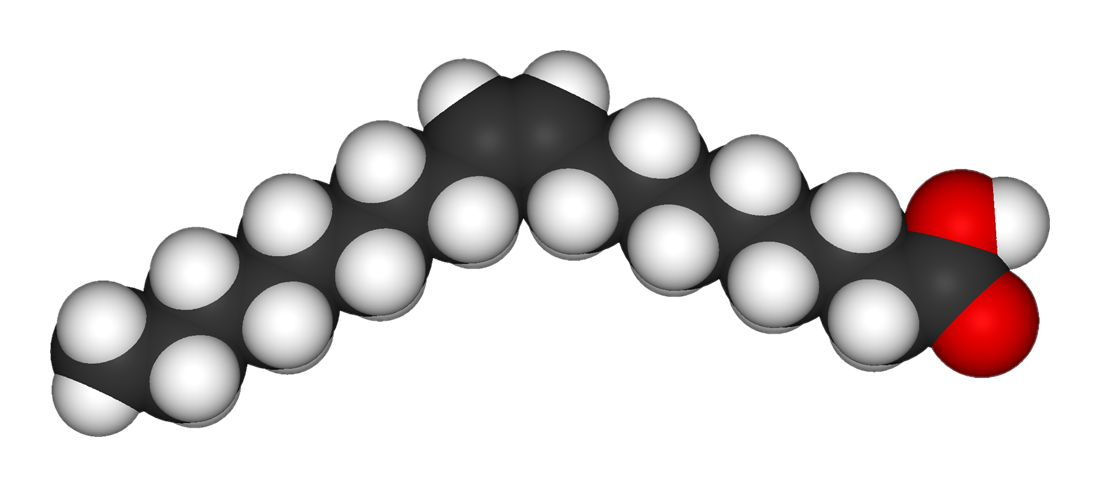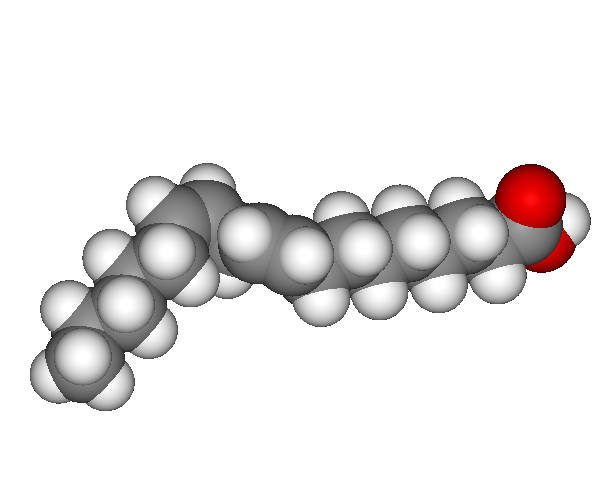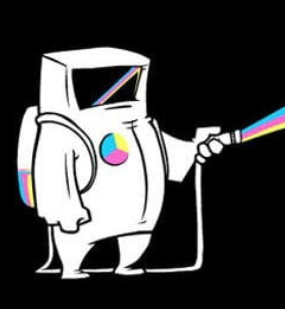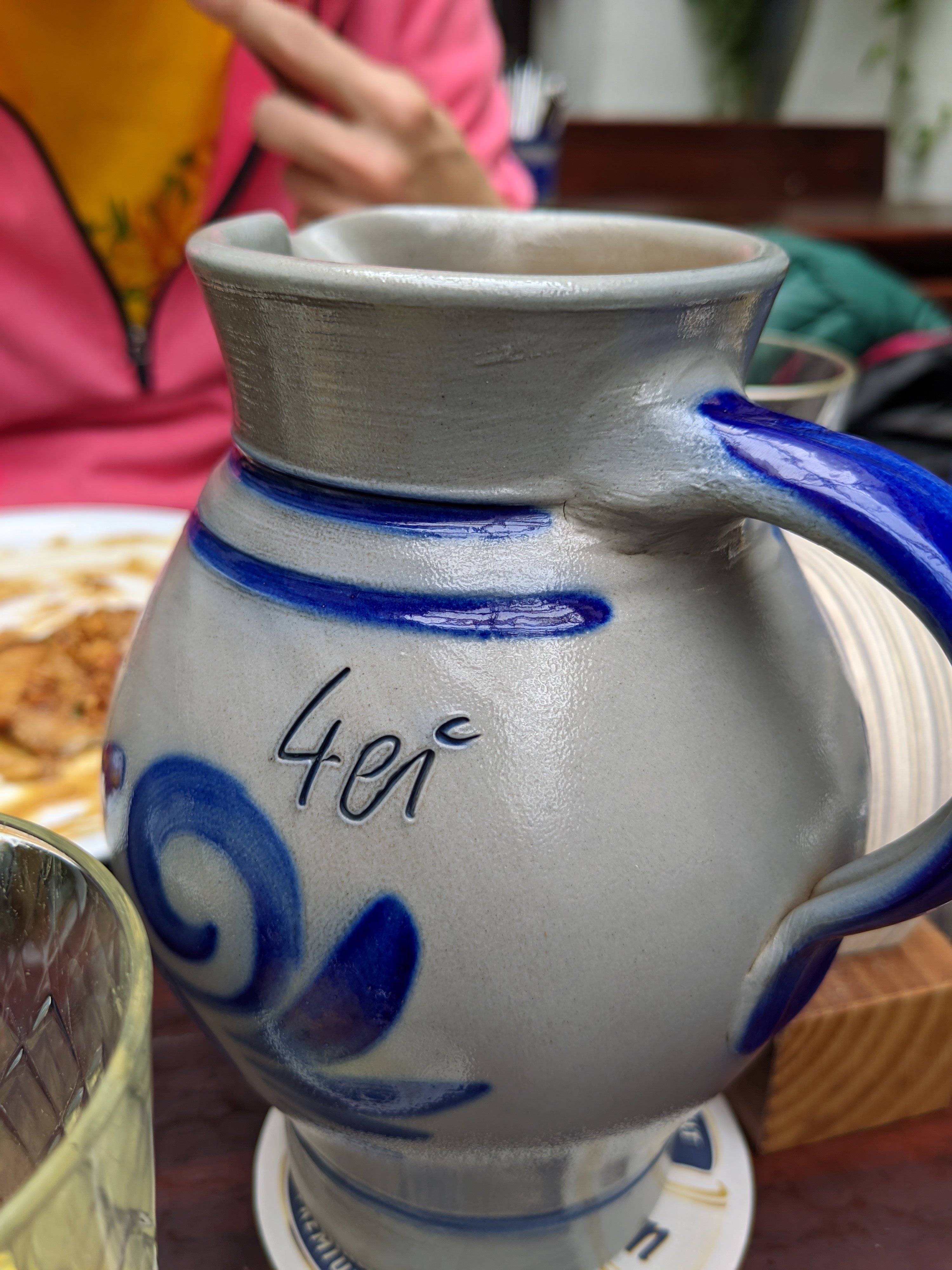And how are those differences relevant to our nutrition and diet?
Other people have described the health effects, so I’ll describe the chemistry. Fats are made of long chains of carbon atoms surrounded by hydrogen atoms attached to a “head”, which is made of other elements or structures. Carbon atoms normally can make a total of 4 bonds. Hydrogen atoms can make 1 bond.
Carbon being able to make 4 bonds means that in the chain of carbon and hydrogen atoms in fat molecules, each carbon atom makes a bond with the carbon atom before it in the chain, a bond with the carbon atom after it in the chain, and then bonds with two hydrogen atoms separately off to the side. This makes a total of 4 bonds. If all of the carbon atoms in the chain are like this, that’s “saturated fat”, because the chain of carbon is completely “saturated” with hydrogen atoms.

(Hydrogen atoms are white, carbon atoms are black, oxygen atoms are red)
Saturated fats have the often desirable property of being able to be tightly packed together, and thus are typically solid at room temperature. Butterfat is mostly saturated fat.
However, carbon atoms can also make a double bond with other carbon atoms. If a particular carbon atom in the chain makes a double bond with the carbon atom before it, it could cause a bend in the chain of carbon atoms. In that case, it also means that those particular carbon atoms in the chain that have formed a double bond with each other only have 1 available bond left (after also forming a separate single bond with the carbon atom before or after it), so it can only bond with one hydrogen atom. These are, therefore, called “unsaturated fats”, and because they don’t pack together easily, they are typically liquid at room temperature.
If there is a single double bond in the chain, it’s a monounsaturated fat.

If there are two or more double bonds, it’s a polyunsaturated fat.

Notice how the hydrogen atoms connected to the double-bonded carbon atoms in unsaturated fats can be connected to either the same side or the opposite sides of the two hydrogen atoms. If they’re on the same side, they are called cis-unsaturated fats. If they’re on opposite sides, they are trans-unsaturated fats, or trans fats in short.
This is oleic acid, a cis monounsaturated fat commonly found in many vegetable oils:

While this is vaccenic acid, a trans-monounsaturated fat. It is found naturally in butter and human milk and is not particularly bad for you:

Note that this is NOT the same picture as the one I showed for saturated fat. The 7th and 8th carbon atoms from the left are double-bonded and, therefore, are each missing a hydrogen atom. The one remaining hydrogen atom on each is bonded on opposite sides.
Note that trans-unsaturated fats are also pretty straight. This means that they can also pack together with saturated fats to make a solid product at room temperature.
“Hydrogenation” is the process of adding hydrogen to unsaturated fats to saturate them. This means that liquid oil can be processed into a solid product. That’s how margarine and shortening are made. In previous years, partially hydrogenated oils that weren’t fully hydrogenated could leave substantial quantities of trans-unsaturated fats left in the product, but after health concerns, many countries’ food safety authorities banned these artificial trans fats. Fully hydrogenated fats consist of only saturated fats since they have been “fully” hydrogenated, and that is what food manufacturers have been doing instead.
Thanks for the explanation! I’ve taken the liberty of posting this to bestoflemmy:
High quality post.
Top 10 lemmy comment IMO.
Had a vague idea, came here for the chemistry. Nailed it!
Saturation when it comes to fats refers to how fully saturated with hydrogen atoms a particular fat molecule is. The more hydrogen atoms a fat molecule is missing from being fully saturated with hydrogen, the more double bonds there are within the fat molecule.
These double bonds introduce kinks that change the shape of a “fully saturated” fat molecule from mostly straight to one that has a bend in it.
Saturated fats are generally straight in shape because they have no double bonds within their hydrogen-carbon structure and thus no bends.
I’ve not heard of the term monosaturated or polysaturated or transaturated myself. I think you mean to say monoUNsaturated polyUNsaturated. Monounsaturated fat means a fat that has one double bond so one bend in its hydrogen-carbon structure. Polyunsaturated fat is a fat that has multiple double bonds and thus multiple bends in its hydrogen-carbon structure.
Trans-saturated fats are made by taking unsaturated fats (mono or polyunsaturated) and bombarding it with hydrogen atoms along with a catalyst to remove the double bonds in the hydrogen-carbon structure and turn the mono/polyunsaturated fat into a saturated fat.
The issue with adding hydrogen atoms this way is it fucks with configuration of the hydrogen-carbon structure turning it into a “trans” configuration that our bodies really do not react well to.
Most of our cell walls are made from mono/polyunsaturated fats so those are more useful to our bodies and taking those are generally better for us than saturated fats are. Trans fats don’t often occur naturally so our bodies don’t really know what to do with them and kind of throw a tantrum when it sees one.
TLDR; Saturated fats are straight in shape, mono/polyunsaturated fats have one/multiple bends. Our bodies need more mono/polyunsaturated fats compared to saturated fats. Trans-saturated fats are artificially created saturated fats made from mono/polyunsaturated fats and are the devil
https://www.mayoclinic.org/healthy-lifestyle/nutrition-and-healthy-eating/in-depth/fat/art-20045550
Here is a link based more on nutrition
The short version is that saturated fats generally have a negative effect on cholesterol, and the recommendation is to limit your intake. They’re popular because they’re found in many animal products, and have useful properties (such as often being solid at room temperature, like butter)
Then unsaturated fats are pretty much the opposite, whether poly or mono unsaturated. They have a generally positive effect on health. Use these when possible.
Most sources of fats are a blend of the different types, so don’t worry excessive about it.
Oh and then trans fats are the worst for you by far and are banned from sale in many places, although you can actually create them in your own kitchen I believe via some methods of deep frying
Alton Brown did an amazingly easy to understand reference for this.
The first four letters.







